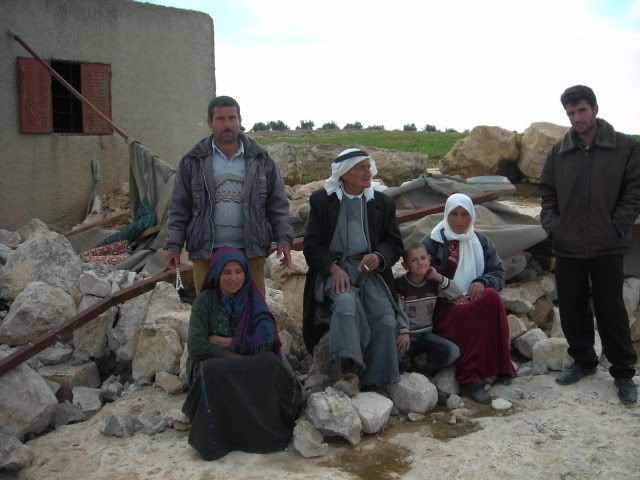
On February 14th, I received confirmation through a CPT report, that the homes of friends of mine in Palestine were destroyed. In one sense, this is also normal, as they were not the first, and won't be the last homes destroyed in Palestine by Israeli soldiers (or Palestinian homes destroyed in Israel for that matter). But truly, how can the demolition of your home by an illegal military occupation ever be considered normal? How can such brutality be carried out by human beings who are just following orders, without some semblance of reflection and disgust? And how do my friends, and countless other Palestinians, find the strength to survive such violence, and not only carry on, but rebuild and hope for the future?
In a moment, I'll be going through the pictures, both from my trip and the current destruction, but first a few more words. I wrote about the community that has suffered this outrage before, in a diary called Close Encounter of an Israeli Settler Kind . It is the village of Qawawis, and the residents have endured numerous acts of violence over the years, the main aim of which is to remove them (and other small villages in the area) from the land.

If one looks at the many maps available, they will show you the logic of the occupation in this area; the less populated (by Palestinians) South Hebron Hills have been targeted for annexation by the Israeli settlers for decades, as opposed to the more densely populated Palestinian areas of Yatta, Samu, and Hebron nearby (that said, Hebron is another story). The villages of Qawawis and many others like them are a problem, not due to 'terrorism' or 'security'as such, but due to their repeated refusal to leave, and their rootedness in the land.
Adi Ophir wrote in an article in the Book, Against the Wall that the occupation is defined not as much by overt acts of violence (although they do occur from time to time), which he calls kinetic violence, but by violence in small bursts, or even more, violence suspended, always there and threatened, always possible, but held back for the present. This is one of the reasons that conveying the terror and violence of the occupation can be deceptive to those that do not understand the way occupation dominates the daily life of Palestinians. But in the time I spent in Qawawis, I witnessed so many small and large examples of violence, it is hard to list them all. Just getting to the village requires a circuitous route replete with checkpoints, backroads and some on-foot traversing; then there was the morning we found 6 olive trees cut down by settlers, the surprise visits by the army, the countless visits to the village by armed and violent settlers. And then there is just the physical setting; Qawawis is ringed to the north, south and east by 3 settlements, and one major highway cuts it off from the village of Karmel. Two more roads branch off the main highway, completing the pincer which surrounds and attempts to choke off any ability to survive for the villages of the region. On top of that, in addition to the Apartheid Wall which passes close to the Green line, they are building an inner wall along the Highway, which will completely seal off the villages from Karmil and Yatta.
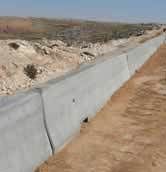
Now I don't just know this because I read Jeff Halper's Matrix of Control article, which describes this basic policy and strategy of control and suffocation that the IOF employs, and is certainly applicable to Qawawis and other parts of Palestine. I know it because I lived it when I stayed in Qawawis. When we would take the goats and sheep out to graze, we could go only so far as the lack of roads and settlements would allow us (to give you some idea, I traverse well more than twice that distance during my 20 minute bike ride to work). And when we would be near the roads, we would be in constant threat of soldiers and settlers, due to military orders which say that they need to stay 200 meters from the roads. Some days, the army jeeps would drive by and ignore us, and some days they would try and force us to leave. Some days, the settlers would ignore us (you can always tell who they are by the orange ribbons, a holdover from the disengagement), or some days they would honk their horns at us, or shout from their cars. And, some days, they would do more, as my previous post explains.
But on February 14th, the suspended violence gave way to a full-scale explosion, in the form of home demolitions, in 3 villages in the South Hebron Hills. First, here is a portion of the Haaretz article that discusses it;
Security forces demolish seven houses in Mt. Hebron villages
By Mijal Grinberg, Haaretz Correspondent and Haaretz Service
Security forces destroyed seven illegally constructed Palestinian houses and 13 other structures Wednesday on the southern slope of Mount Hebron in the West Bank.
The demolitions took place in the villages of Manzal, Umm al-Khir and Gawawis.
The Civil Administration said, "Twenty illegal structures were destroyed after demolition orders were issued, and offers were made to the owners to pursue the available options before the planning organizations. The supervisory unit of the civil administration will continue to operate against illegal building activity in the area, and to implement the steps mandated by law against this illegal activity."
And if you would like to see some of the reuters pictures of that day, go here
And here is the CPT report, which was emailed to me by Joe Carr & posted on the ISM site, and is fully approved for reposting;
CPT: Israeli military demolishes seven Palestinian homes in south Hebron district
Israeli soldiers demolished homes in three Palestinian villages near bypass road 317 on February 14, 2007. Starting in Imneizil at around 9am about forty Israeli soldiers with two bulldozers demolished one home, an animal pen and a stone bake-oven. At noon the soldiers moved to Qawawis where they demolished the homes of five families and one bake-oven, then on to Um Al-Kher where they demolished one home and damaged a wall of another home.
At Imneizil several young children were in their home eating when the Israeli military arrived; the soldiers gave the family time to get out, but did not give them time to remove their personal belongings. The animal pen was demolished with a few animals inside; two lambs were injured. The Palestinian family began immediately to build a makeshift pen for the animals as the majority of the sheep were just returning from grazing in the fields.
In the village of Qawawis one of the demolished homes was over sixty-five years old, and sheltered two families. Photos of the families amid the rubble are on the CPT photo gallery: www.cpt.org/gallery/view_album.php?set_albumName=album93
The Israeli military, in concert with Israeli settlers, has been trying to force the Palestinian residents of the south Hebron hills to leave their homes for years. Due to harassment from the nearby Israeli outposts several of the young families of Qawawis moved to a nearby town; when the Israeli army then forcibly evacuated the remaining families, a court ordered that the families could return to their homes. According to a lawyer representing the families, the Israeli army now claims that this court ruling allows only the last inhabitants of Qawawis to return, not their children who earlier fled the assaults of the Israeli settlers.
“Our children need homes,” said one villager. “What do they want us to do?”
The Israeli army said, “Twenty illegal structures were destroyed after demolition orders were issued, and offers were made to the owners to pursue the available options before the planning organizations. The supervisory unit of the civil administration will continue to operate against illegal building activity in the area, and to implement the steps mandated by law against this illegal activity.” The Israeli military made no provisions for shelter for the families whose homes they demolished. The families asked the International Committee of the Red Cross to provide them with tents.
The Israeli Committee Against House Demolitions said, “A building permit is unavailable there [in the south Hebron hills].” The preceding day three Israeli peace activists and two internationals, including CPTer Sally Hunsberger, joined approximately fifty Palestinians in working on their land near Imneizil. The Palestinian men, women and children planted 600 olive trees in fields that they had afraid to walk on for the past four years due to threats of settler violence. During the action, soldiers and settlers watched from a distance, but did not interfere with the tree planting.
Now, I would like to walk through some of the pictures, which consist of the day's destruction, and my own pictures that precede it. It was especially painful to see these pictures, as these are people that fed and took care of me, in whose homes I slept and ate, and whose children I played with.

First, here is a picture of Qawawis from sometime bin 2004-2005, with the house of Hajj Khalil in the center. The land is farmed for olives, almonds and figs on the hills, and elsewhere for wheat and grazing for livestock.

Next to Hajj Khalil's house is the smaller structure that the internationals would sleep in. It is made of stone, mud & cement, with a tarp for a roof (after the rain, the water would collect in bunches and we would have to take sticks to push it out). The winter was cold there, but we would always gather in Hajj Khalil's house for sweet tea to warm us up.
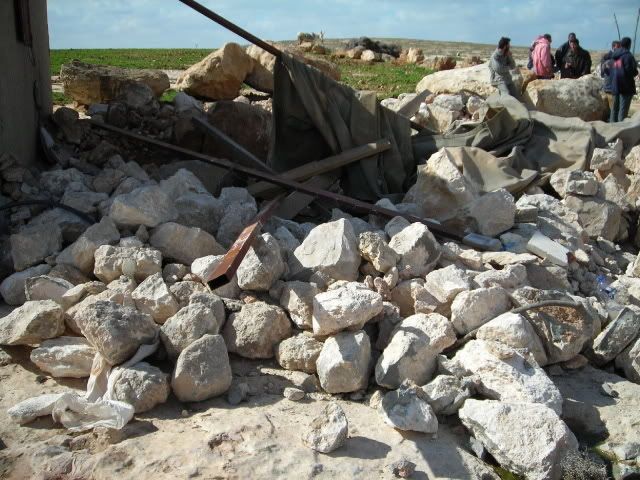
And here are the remains of the home I stayed in, stones, tarp & all.

In the center of this picture is my dear friend, Hajj Ibrahim, and to his right, his wife Hajja Amne. Of the homes there, only Hajj Khalil's, seen behind them, still stands.

Now, this is a picture of my lame attempt to put together a family tree of the families of Qawawis, and I show it to you as my excuse for not remembering everyone's names in the photographs; the families are big, and it has been almost a year since I was there last, so my apologies!
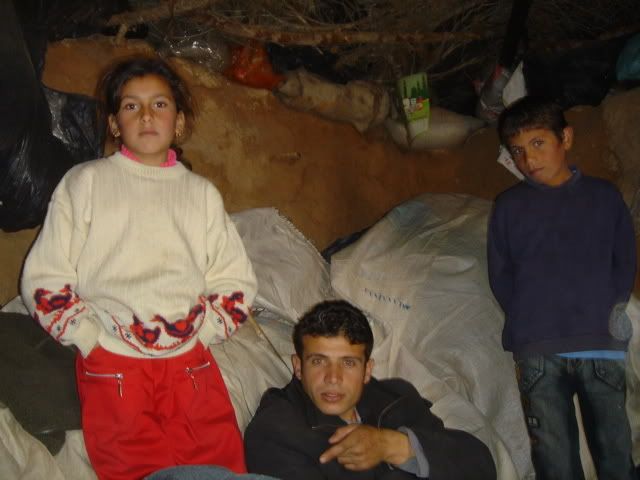
Here I am in the home of Ibrahim, son of Hajj Mohammed who lives in the nearby village of Karmil. In the center is Ibrahim's son Mohammed, who lives and works in the nearby town of Yatta and teaches English. He was very welcoming, his English was excellent, and I enjoyed spending time with him there. One of the great things about staying in Qawawis was that it really forced me to learn some Arabic, as few spoke English, but when he was there, I luckily had some help!

The taller boy is Salah, and the younger one is either Eyal or Lohai, I honestly forget! I remember playing soccer with them & I twisted my ankle on the rocky terrain (that said, one of the kids was playing barefoot!)
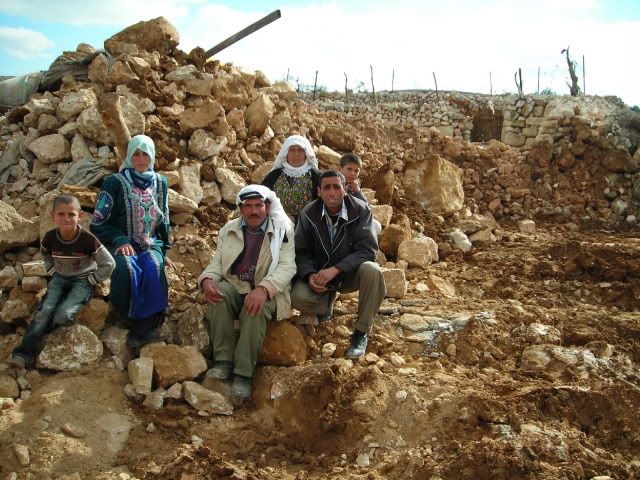
Here is Ibrahim, sitting with his family in the ruins of his home, the one in which I took the previous pictures. To this day he bears an injury to his leg from a confrontation with soldiers years back (he was audacious enough to take his flock by the highway, can you believe that?).
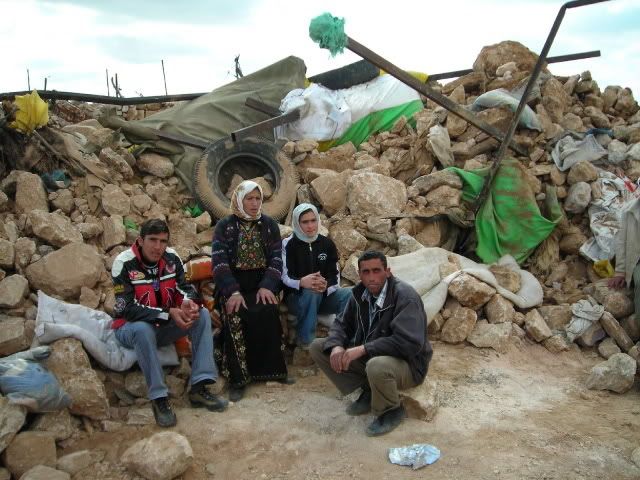
The house is shared with his brother Abed, whose wife Mariamme is here in front of the tire.
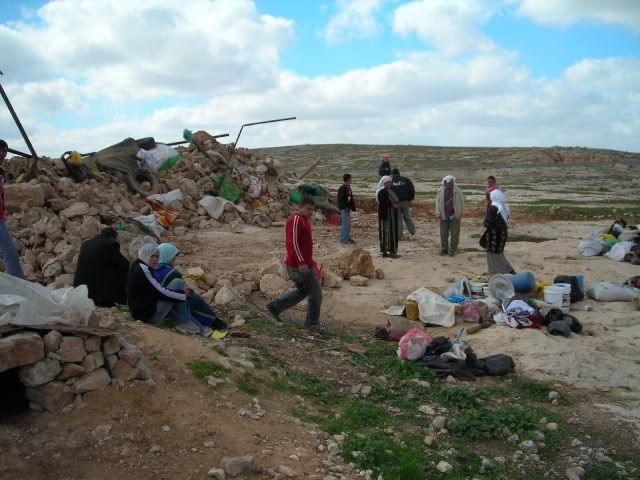
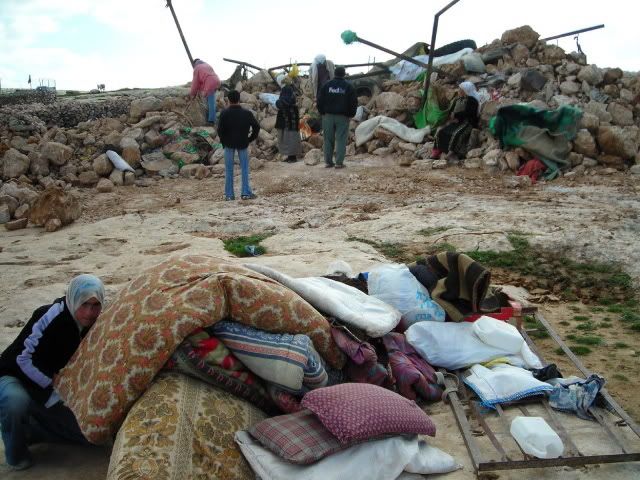
some of their possessions that survived the destruction.
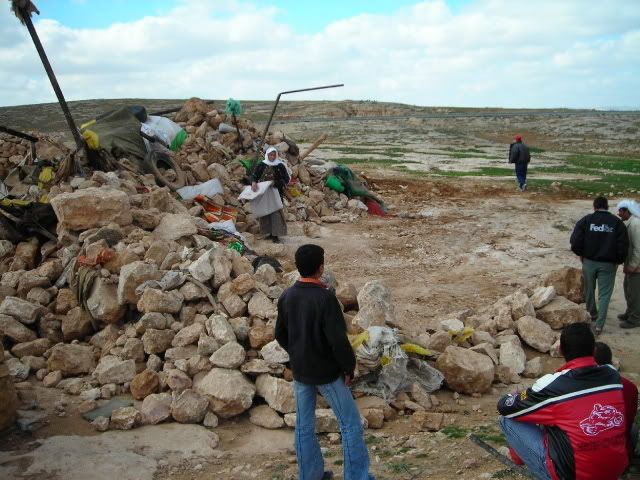
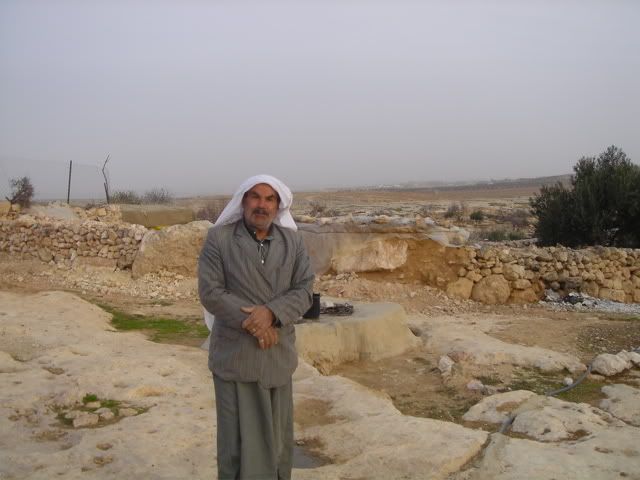
Here is a picture of Hajj Mahmoud from last year. He was a funny guy and fed me many times in his home. He also was a bit impatient with my steep Arabic learning curve; as soon as I would figure out a word or an expression of the most rudimentary sort, he would jump straight to full-speed Arabic! I had to learn how to say to him "slow down, I know very little Arabic;" needless to say, I forgot how to say even that.
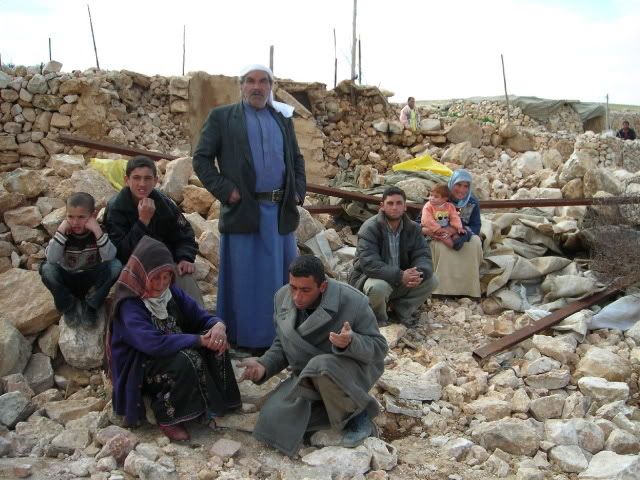
Here is Hajj Mahmoud after the destruction of his home, with his wife Aisha and his son Ziad, who's wife was pregnant and has since given birth to their first child. Now they are all homeless, from the newborn to the grandfather.
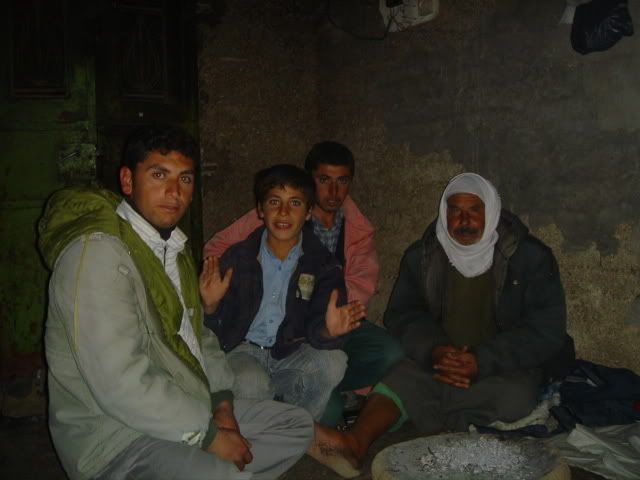
Here I am in the home of Hajj Khalil with Mahmoud's son Ziad. Khalil and Ziad had just come back from Karmil after voting in the January 2006 election, fingers purple and all. Hajj Khalil was truly kind to me, and I look forward to seeing him and his family again; who knows, maybe I can help with the rebuilding of their homes, as rabbis for Human Rights and others have pledged to help them rebuild.
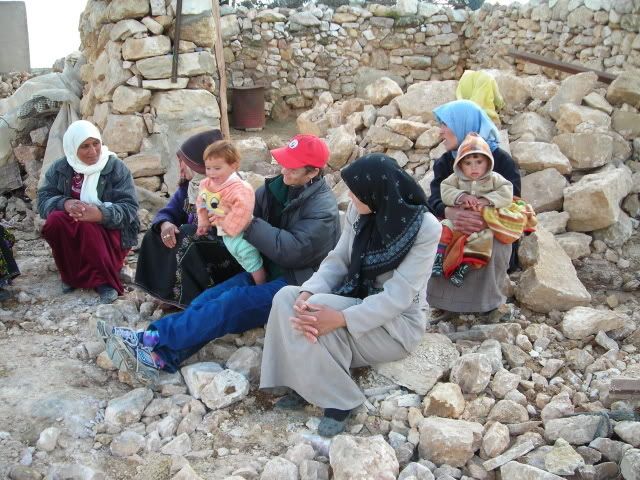

This is Hajj Khalil, just minutes before the settler came and attacked us, as described in my diary Close Encounter of an Israeli Settler Kind . The man is over 80 years old, and despite everything, both he and his family will refuse to leave their land.

Who is the Terrorist?
2 comments:
A beautiful, heartwrenching diary, jon. Do you want to add some labels?
how do I add labels?
Post a Comment